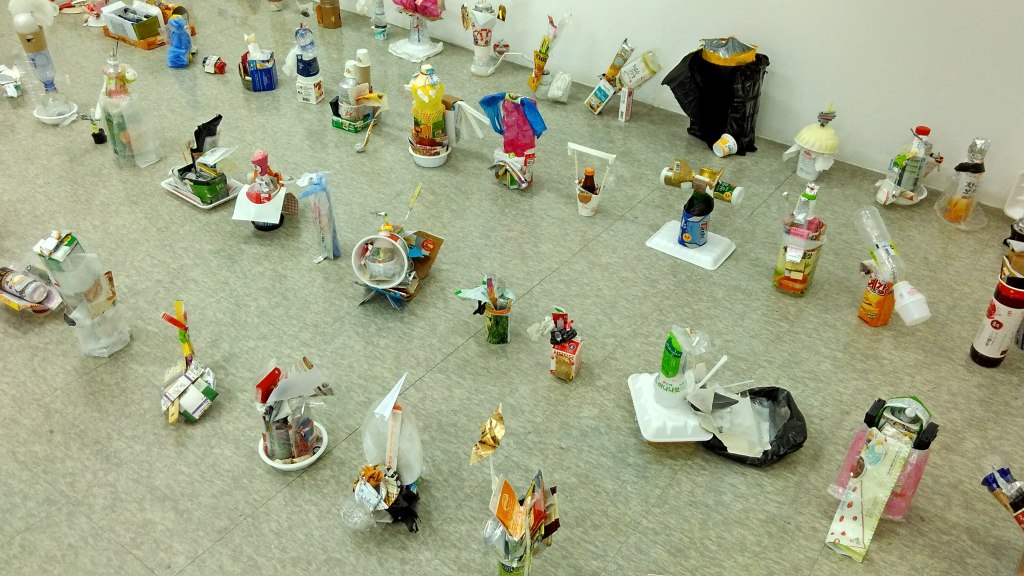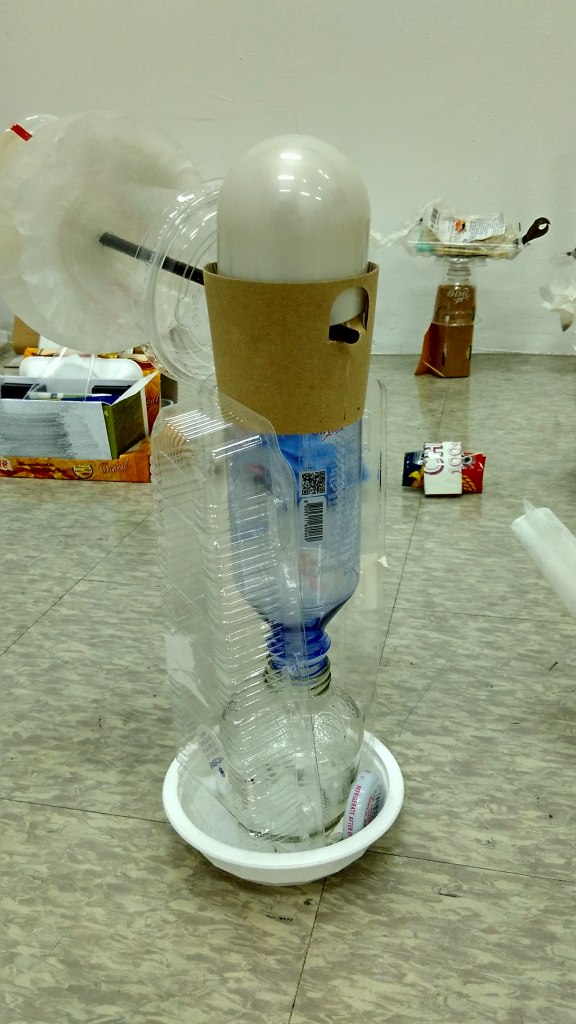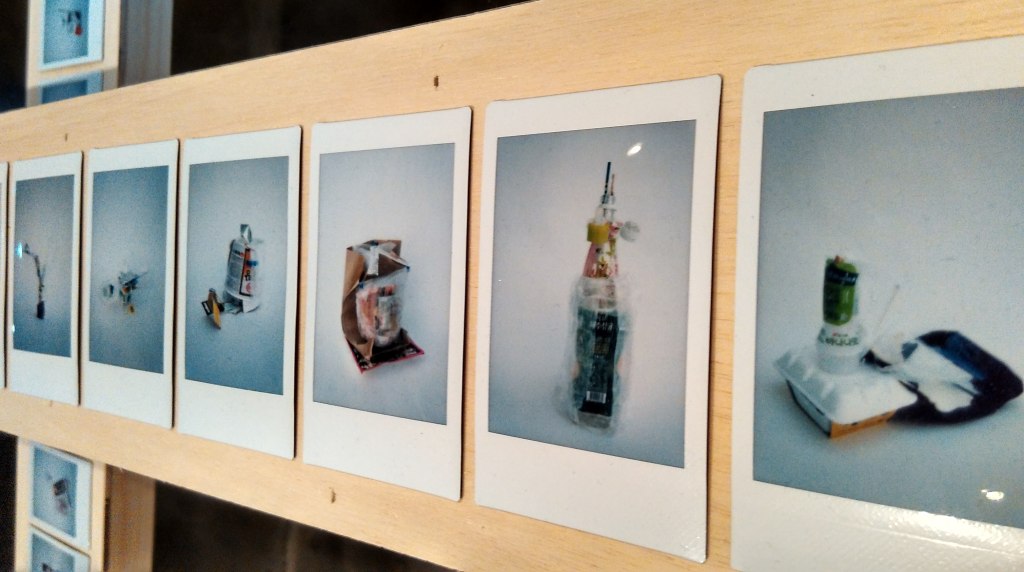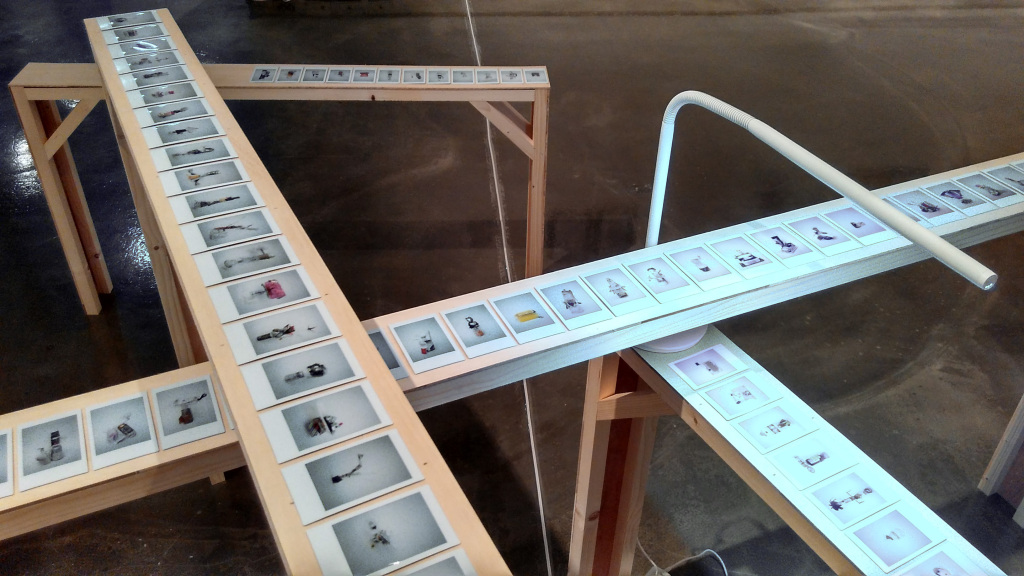Midori Harima’s Democracy Demonstrates – What I have consumed in 90 days in Korea was one the works at the MMCA Goyang The Big Scene: Seven Sights exhibition. I instantly felt very connected to it and enchanted by it.
First a brief description: Harima collected each day’s trash and assembled it into a modest ‘sculpture’ which she then documented with a small Polaroid photograph. The photographs were mounted on wooden structure made from narrow wooden planks and I heard rumors about a future book project. Up in the open studio visitors could get a one-time chance to see the actual sculptures, before they will probably be destroyed.
There is an intimate connection between the objects that surround us. We touch them, they touch us. The door handles and bathroom towels, but also the milk bottles and cereal packaging. Lee Kit’s work from a few years back works closely with this feeling: The painted tablecloths and arrangement of plastic bathrooms utensils; the pastel colors echoing cosmetic brands that come closer to us than other human, seeping into our skin. In the one-to-one relationship, objects are personified, almost like a human counterpart. We build an emotional relationship with them. (Bares, 2013)
“It was just a thing, taken for granted, not worthy any attention. But now his clothes were ruined and sticking to his skin. Even worse, because of all this he was late. He blamed the mug for it as if it had decided to fall apart, to stop being a useful mug.” (Candlin & Guins, 2009, p. 455)
In Democracy Demonstrates, Harima takes up this feeling of intimacy, but goes one step further by self-reflecting on its origins: Where do these objects come from, and where do they go?
“The use of things, in the broadest sense, is not a space necessarily made manifest by its own production. (..) It is through this multitude of possibilities that individuals write themselves into the dominant material text, and alter its fabric. An equivalent could be the construction of sentences within an established verbal vocabulary and syntax. As Michel de Certeau proposed: “consider the use of things as analogous to the speech act within the linguistic system.”” (Cummings, 1993, pp. 19-20)
Harima catalogs and compiles the useless leftovers of the consumer objects that pass through her hands every day. In an act of creative dissent, she diverts the life of these objects. As Cummings states, objects take a life on their own once they leave the factory doors. The time of consumption is accounted for in the product design, expiry dates etc., but it can never be fully controlled. The temporality within which Harima acts is a micro-version of the temporary autonomous zone (Bey, 2011), a short-lived moment in which the relationships between actors (persons, objects, and networks – Latour, 2005) enter a zone of pure possibility. Democracy Demonstrates takes on the human – object relationship within a specific moment of the product life cycle: The passing of a boundary, an ontological rupture when use changes to post-use.
The work records consumption as a repetitive an ongoing process, a real-time system of changing relationships between things and their owners/users. The work also re-frames the objects in question. It acknowledges that the relationship between a humans and things does not exist in a vacuum, but relates to a specific site at a specific time. It is done by taking the object out of its habitual time and site. The daily trash-sculptures are frozen in time, both as objects as well as photographs that serve as second level signified of the underlying consumer process.
The approach taken by Harima can be traced back to a Duchampian heritage. But Democracy Demonstrates is neither a straightforward appropriation, nor a balancing act. It is not a transformation and quoting of things that exist within another context, as it has been done by pop artists from Warhol to Koons. Instead Harima’s approach accounts for how the objects are made and then re-uses the method of how they are made, which makes the sculptures look familiar even though they did not exist before.
Harima gazes at the object, yet it is not a consumption-driven desire that directs the gaze, much more it is an emphatic gaze, which is as much self-aware as object-aware. Object and human meet at equal terms aware of their own limitations and capabilities. They unite for a fleeting moment and then part again in their separate yet interconnected lives.
Following are photos of the actual sculptures presented in the open studio:




References
Bares, J. (2013, 2 1). Lee Kit “Every Breath You Take”. Retrieved from ecr229.culture360.asef.org: http://ecr229.culture360.asef.org/2013/02/01/lee-kit-every-breath-you-take/
Bey, H. (2011). T.A.Z.: The Temporary Autonomous Zone. CreateSpace Independent Publishing Platform.
Candlin, F., & Guins, R. (2009). The Object Reader. London and New York: Routledge.
Cummings, N. (1993). Reading Things: the alibi of use. In N. Cummings, Reading Things (pp. 13-29). London: Chance Books.
Latour, B. (2005). Reassembling the Social: An Introduction to Actor-Network-Theory. New York: Oxford University Press.

